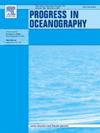西热带太平洋中硝酸盐的同位素组成:生物地球化学信号及其运输
IF 3.6
3区 地球科学
Q1 OCEANOGRAPHY
引用次数: 0
摘要
热带西太平洋具有复杂的环流系统,在调节全球海洋氮循环和收支中起着重要作用。通过使用硝酸盐同位素(δ15N-NO3-和δ18O-NO3-)技术可以获得强有力的见解。在本研究中,在西热带太平洋沿经向(130°E)和纬向(20°N)样带获得了硝酸盐浓度和δ15N-NO3-和δ18O-NO3-值。δ15N-NO3-值为2.9 ~ 10.9‰,δ18O-NO3-值为2.0 ~ 5.7‰。对于源自北太平洋的温跃层水团,δ15N-NO3-和δ18O-NO3-同时升高表明硝酸盐同化。中间水体δ15N-NO3-值相对较低,表明浅层固氮产生的下沉有机质有再矿化作用,但这些信号在北太平洋副热带环流中向下传播有延迟。对于起源于南半球的水团,硝酸盐同位素的变化可能主要归因于物理混合,包括温跃层与中间水之间的横旋混合以及来自赤道潜流的侧向平流。此外,根据端元混合计算,北地下逆流水体中至少62%的硝酸盐来自南半球,而北太平洋热带水、南太平洋热带水和富营养化上升流分别占北赤道逆流水体中硝酸盐的50%、12%和38%。本文章由计算机程序翻译,如有差异,请以英文原文为准。
Isotopic composition of nitrate in the Western Tropical Pacific Ocean: Biogeochemical signals and their transport
The Western Tropical Pacific Ocean has a complicated circulation system and plays a significant role in regulating global marine nitrogen cycles and budgets. Powerful insights can be gained by using nitrate isotope (δ15N-NO3- and δ18O-NO3-) techniques. In this study, nitrate concentrations and δ15N-NO3- and δ18O-NO3- values were obtained along meridional (130°E) and zonal (20°N) transects in the Western Tropical Pacific Ocean. The δ15N-NO3- and δ18O-NO3- values ranged from 2.9 to 10.9 ‰ and from 2.0 to 5.7 ‰, respectively. For the water mass in the thermocline originating in the North Pacific, the simultaneously elevated δ15N-NO3- and δ18O-NO3- values indicated nitrate assimilation. The relatively low δ15N-NO3- values in the intermediate water indicated the remineralization of sinking organic matter produced by N2 fixation at shallow depths, but these signals exhibited a delay in downward propagation in the North Pacific subtropical gyre. For water masses originating in the Southern Hemisphere, the variations in nitrate isotopes might be attributed mainly to physical mixing, including diapycnal mixing between the thermocline and intermediate water and lateral advection from the Equatorial Undercurrent. Furthermore, according to end-member mixing calculations, at least 62 % of the nitrate in the water of the North Subsurface Countercurrent was derived from the Southern Hemisphere, whereas North Pacific Tropical Water, South Pacific Tropical Water and nutrient-rich upwelling accounted for 50 %, 12 % and 38 %, respectively, of the nitrate in the water of the North Equatorial Countercurrent.
求助全文
通过发布文献求助,成功后即可免费获取论文全文。
去求助
来源期刊

Progress in Oceanography
地学-海洋学
CiteScore
7.20
自引率
4.90%
发文量
138
审稿时长
3 months
期刊介绍:
Progress in Oceanography publishes the longer, more comprehensive papers that most oceanographers feel are necessary, on occasion, to do justice to their work. Contributions are generally either a review of an aspect of oceanography or a treatise on an expanding oceanographic subject. The articles cover the entire spectrum of disciplines within the science of oceanography. Occasionally volumes are devoted to collections of papers and conference proceedings of exceptional interest. Essential reading for all oceanographers.
 求助内容:
求助内容: 应助结果提醒方式:
应助结果提醒方式:


